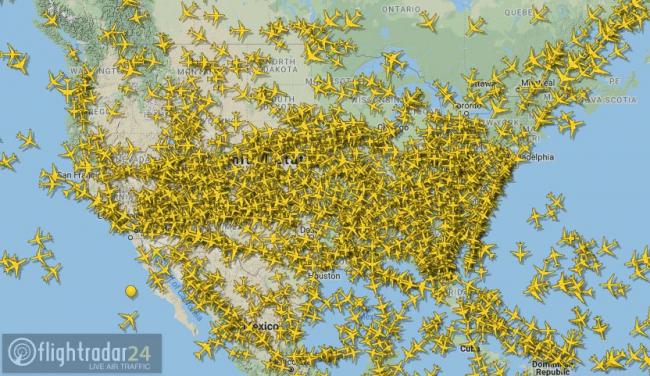January 7th 2020
The global aviation industry has started burning jet fuel like there is no tomorrow. Its climate pollution is rocketing upward. And hoped-for "solutions" like biofuels and electric planes are being buried by the rising flood of emissions. In response, a growing number of climate-concerned people, including the world's most famous climate champion, Greta Thunberg, are advocating for less flying.
If you're interested in an illustrated guide to the hot topic of soaring flight pollution and what's being done about it, you're in luck. I've read dozens of detailed reports, built the geeky spreadsheets and created a series of charts that tell the story.
CO2 taking off
Let's start by looking at the dramatic rise in climate pollution from global aviation. My first chart shows past and projected CO2 data from the International Civil Aviation Organization (ICAO) and the International Air Transport Association (IATA).
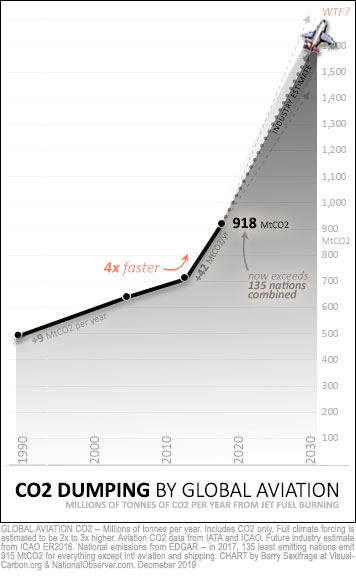
As you can see, the aviation industry's climate pollution is taking off. Its CO2 is now rising four times faster than its already scorching pace in previous decades.
The burning of jet fuel is increasing by an additional 44 million litres every day — an additional 16,000 million extra litres each year. That's like burning 1,000 tanker trucks more than the day before. And then 1,000 more than that the next day … ad nauseum.
The International Energy Agency (IEA) credits the "spectacular expansion" of jet fuel burning, along with increasing plastic production, for fuelling the vigorous rise in global oil demand.
At current rates, the aviation industry will soon be dumping a billion tonnes of CO2 per year into our atmosphere. That exceeds the combined emissions of 135 nations … for everything.
As the soaring dotted line on the chart shows, the industry isn't planning to stop at a billion tonnes. They are spending trillions of dollars to buy more jetliners, expand airports and build the fossil fuel infrastructure that will push their climate pollution to ever more dizzying heights.
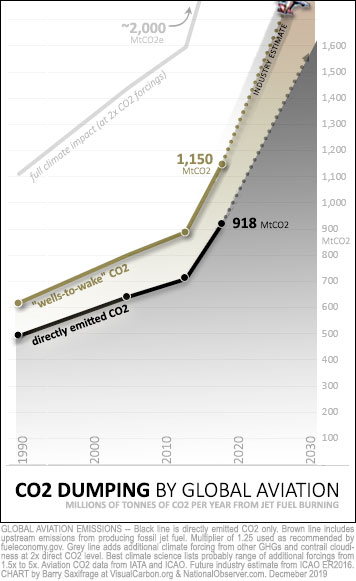
And that’s just the portion of their climate pollution the industry is willing to count.
As my second chart shows, the upstream emissions from producing jet fuel (a.k.a. "wells-to-wake" accounting) pushes aviation's CO2 impact significantly higher.
On top of that, the best climate science indicates that burning jet fuel in the upper atmosphere creates additional warming from other greenhouse gases and contrail cloudiness. While less well quantified, the full climate impact is estimated to be between 1.5 times CO2 at the low end, and five times CO2 at the high end. The grey line in the chart shows that at two times CO2, aviation's full climate impact already exceeds two billion tonnes.
Is it any wonder that kids are taking to the streets in worldwide protests to try to save themselves? As Greta Thunberg laments to Time magazine: “We can’t just continue living as if there was no tomorrow, because there is a tomorrow.”
One of the world's dirtiest industries
Aviation's soaring climate pollution carries another large, though little appreciated, climate risk: the industry produces very little value from each tonne of CO2 it emits. The economists' term is "high carbon intensity," while a more colloquial term is dirty dollars.
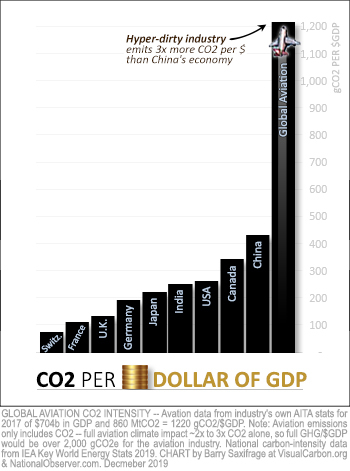
My next chart lets you quickly compare how the global aviation industry compares to some of the world's major economies.
The industry's own GDP and CO2 numbers show they emit around 1,200 grams of CO2 per dollar of GDP they produce. For context, China's coal-choked economy emits only a third as much CO2 per dollar.
The aviation industry says: "If aviation were a country, it would rank 20th in size by GDP (similar to Switzerland)." What they don't mention, but the chart shows clearly, is that the industry dumps 15 times more climate pollution than Switzerland to get there.
However you slice it, there is growing risk — to industry, investors and humanity — from driving such a breakneck expansion of a "three-times-dirtier-than-China" industry into the teeth of the gathering climate storm.
But, aren't there technology solutions coming — like electric jetliners and biofuels — that will clean up flying? Good question. Let's next take a look at what the industry is planning for each, and you can decide for yourself.
How much can electric planes help?
There are many hopeful stories about electric planes these days. Can e-flight solve aviation's climate problem?
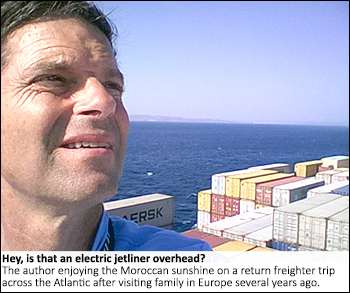
I wish!
I love travelling. But I also decided to stop flying more than a decade ago because of the oversized climate damage even one long-distance flight creates.
So, I'd be one of the first and most eager customers for zero-emissions electric flights. I'm an e-flight fanboy and try to keep up with the technology closely. One can dream…
Unfortunately, as the industry regularly points out, 80 per cent of aviation CO2 is emitted from flights over 1,500 kilometres in length. Sadly, none of the dozens of proposed all-electric airplanes plan to fly anywhere close to that far. As a study this year by the International Council on Clean Transportation (ICCT) concluded: "Electrifying commercial aircraft does not appear feasible in the 2050 time frame, except for short-haul flights."
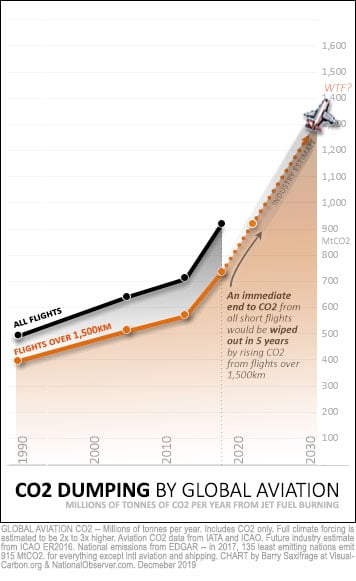
And even if humanity electrified every short-haul flight, it would not stop aviation emissions from soaring. To illustrate why, I've updated my first chart to include a line showing CO2 from flights over 1,500 km.
As this rising orange line makes clear, long-haul flights are increasing so fast they will exceed today's total aviation emissions in just five years.
So even an immediate global ban on all flights less than 1,500 km would be wiped out within five years by surging long-haul flight emissions.
In reality, switching all short-haul flights to clean electricity will take decades. Huge fleets of new electric jetliners need to be developed, tested and produced. Existing jetliners written off. Every airport will need massive new electricity supplies capable of fast-charging multiple jetliners at a time. And all those super-grids will need to be powered by newly developed zero-carbon electricity installations. That's a lot of money and effort to not solve the problem. That's doubly true when we already have solutions for short-haul distances via low-carbon ground transportation.
So, if electric planes can't stop jet fuel CO2 from soaring ever upward, what can?
The industry claims that huge quantities of bio-jet fuel are the only way to lower the amount of CO2 they emit. A growing number of climate-concerned people are instead advocating for fewer flights to ensure aviation's CO2 emissions start falling. Will the climate solution to flying come from mountains of bio-jet or capping flights? Or both?
How much can bio-jet help?
The industry says "sustainable aviation fuels" are crucial to their "licence to grow." As a Boeing executive told Bloomberg: "There is a tremendous amount of determination to make biofuel work because we just don’t have any alternative." Well, other than capping the rise in flights. The International Renewable Energy Association (IRENA) says bio-jet is the "only real option to achieve significant reductions in aviation emissions by 2050." Again, other than halting flight expansion, that is.
Unfortunately, bio-jet is languishing as a "fuel nobody makes in volume." My next chart tells the story. It shows jet fuel use, in billions of litres per year.
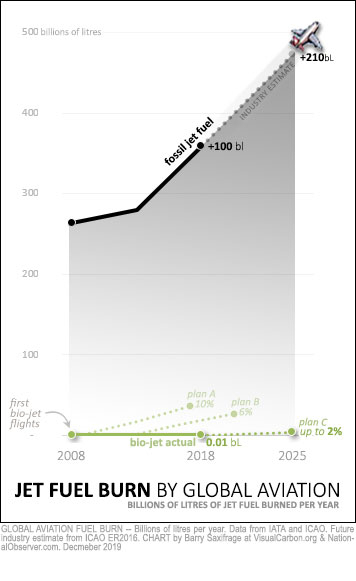
The bottom green line shows bio-jet plans versus production, since the first bio-jet flights a decade ago.
Back in 2009, the industry heralded a clean future via bio-jet. "Look at our amazing work on biofuels. They have the potential to reduce our carbon footprint by up to 80 per cent. IATA set a target of 10 per cent alternative fuels by 2017." (H/T Dan Rutherford at ICCT)
But when 2017 arrived, the airlines bought thousands of times less than that — just 0.002 per cent of their fuel use. So much for plan "A."
In the meantime, the airlines increased their fossil jet fuel purchases by 10,000 times as much. In fact, fossil jet fuel use is now rising more every four hours (+10 million litres) than bio-jet has managed to do in a decade (+7 million litres).
Ever-shrinking targets
My chart also lets you see the discouraging trend toward ever-smaller bio-jet targets. In 2009, the industry's target was for 10 per cent bio-jet by 2017. By 2011, they cut it sharply to six per cent and pushed out five years. Now, in 2019, the target has been slashed to just one or two per cent by 2025. And even that amount is considered unlikely unless governments jump in soon to help pay for it.
Collapsing investment
With the aviation industry unwilling to pay the higher price of bio-jet, production has faltered. Indeed, global investment in all biofuels has fallen off a cliff — down 90 per cent from a decade ago.
At this point, promises of gigantic surges in bio-jet — like the rapid 10,000-fold increase underpinning the ICAO's climate solution called "Vision 2050" — are so wildly beyond what is actually being funded that they've become just another form of predatory climate delay like "clean coal" and "clean diesel."
Peak flight?

“I’ve decided to stop flying because I want to practice as I preach, to create opinion and to lower my own emissions... If a large number of people do this, then it will. It sends a message that we are in a crisis and have to change our behaviour.”
– Greta Thunberg, 16-year-old Swedish climate strike leader
With aviation's emissions soaring and its promised climate solutions failing to arrive, a growing number of climate-concerned people are boycotting flying and advocating for a halt to flight expansion ("peak flights").
The most famous flight boycotter, of course, is Greta Thunberg. The worldwide media coverage of her efforts to avoid jet travel has propelled the threat of rising flight emissions into the global conversation. Her nomination for the Nobel Peace Prize, followed by being named Person of the Year by Time magazine, has amplified it further. The idea of fewer fossil-fuelled flights has emerged into both personal and policy discussions.

To illustrate the potential climate benefits of capping flight levels, I've added a "peak flights" scenario in which flights remain at current levels. It's the falling dotted green CO2 line.
As you can see, flight emissions would fall steadily even as the amount of flying stayed the same. The falling CO2 would come from the industry's ongoing efficiency gains. In this illustrative scenario, I've assumed the industry meets its target of increasing fuel efficiency by two per cent each year.
If the world wants to quickly and consistently cut the amount of climate pollution from the aviation industry, "peak flight" is the only solution being discussed that can do it. In fact, "peak flight" has the potential to cut aviation emissions in half by 2050, all without reducing today's level of flights.
Instant climate progress. No techno-miracle required. And, as a bonus, we get to avoid ugly global struggles over food-versus-fuel, flying-versus-forests and who gets access to the planet's remaining biomass. It's no wonder that enthusiasm for limiting flights is taking off.
[Top image: Real-time flight mapping by flightradar24.com -- December 18, 2019]
